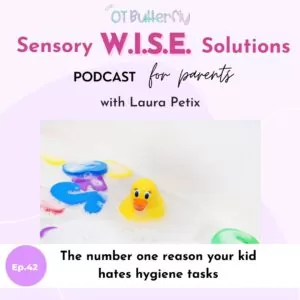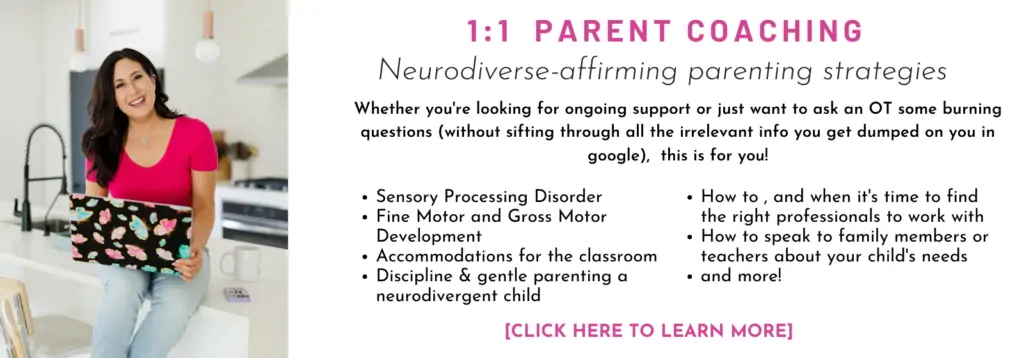Get your FREE sensory profiles cheat sheet >>click here<<
The Number One Reason Your Kid Hates Hygiene Tasks
Do you ever worry that your neighbors might call CPS on you for the blood-curdling screams your child lets out during bath time?
What about teeth brushing, or hair brushing?
Nail cutting?
What do all these things have in common?
They’re grooming tasks that are commonly stressful for sensory-sensitive kids, and while they may seem dramatic, I’m here to tell you their experience is real.
Here’s why your kid might hate grooming tasks
The thing about grooming tasks is they’re typically out of the child’s control; it’s something that is being done to them.
You wash their hair.
You cut their nails.
You’re 1 inch away from putting them in a choke-hold just to prop their mouth open to brush their teeth.
While most people like to be in control of their bodies, it’s even more true for sensory-sensitive children.
Kids who are sensory sensitive to things like touch tend to prefer to be in control of the input.
It makes sense, right?
When you’re in control of the stimulus, you feel safer and more confident.
When you’re not in control of it, you feel vulnerable.
The underlying sensory triggers in grooming tasks
So let’s dive a bit deeper. Your child may hate grooming tasks because it’s out of their control, but what sensory systems are most at play here?
8 sensory systems comprise our nervous system, but the main sense that triggers meltdowns around grooming tasks is the tactile (touch) sense.
[Click here for a free guide to learning about the 8 sensory systems]
For example, many kids with sensory sensitivities complain of discomfort or pain with:
- Water dripping down their face/body when you rinse their hair
- The feel of the nail clipper against the underpart of their nail
- The stickiness/sliminess of lotions you rub on their body or face
- The texture and feel of toothpaste or the toothbrush against their gums/mouth
Auditory sensitivities may also be triggered from some grooming tasks, such as:
- The sound of running water from the bathtub or sink
- The sound of clippers for haircuts
- The sound of the toilet flushing or the echoes from the bathroom
Lastly, if you have a vestibular sensitive kid, they may dislike rinsing their hair in the bathtub because of the feeling they get when they have to tilt back their head, which can trigger a startle response and make them feel like they’re falling.
Here’s where grooming gets tricky
Even when something starts as a sensory sensitivity (e.g. your child’s discomfort with the feeling of their hair being rinsed), it can transform into a stronger, learned fear or avoidance of that activity.
More specifically, these non-negotiable grooming tasks that you have to force your child through often can create strong anxiety or fear in their brain.
As their brain continues to experience this fight or flight protective response in the context of the bathroom, for example, the brain starts to create shortcuts to avoid it.
So now the child may start crying right before bathtime or as soon as you mention the word bath time rather than crying or fighting during bath time.
Don’t panic, you can help them feel safe around grooming tasks.
Take a deep breath.
You have not traumatized your child by bathing them or brushing their teeth.
You are keeping them safe and hygienic and doing what’s best for them.
Take another deep breath.
You can start slowly un-doing that scare factor that unfortunately has been associated with some grooming tasks due to your child’s sensory profile.
Creating positive associations with grooming tasks
Start creating positive associations with the environment and the context of that grooming task.
What do I mean by that? Here are some examples:
- Bathtub: create positive associations by playing in the bathtub NOT during bath time. Turn it into a huge sensory bin, let them play in there without water, or turn it into a cozy reading nook. Click here for other bath time ideas.
- Bathroom: create positive associations by bringing toys in there, playing with legos, and going in there often at neutral times. I mean actually sitting on the bathroom floor and playing with legos.
- Toothbrush: allow them to brush your teeth, allow them to use another toothbrush (buy one from the dollar store) to do crafts with, or brush dolls’ teeth
Keep in mind, that you may be working against years of negative associations with the grooming task, so this isn’t an overnight fix.
In addition to being intentional about creating more positive associations with the context of these tasks, you also want to create more patterns of consistent regulation.
Consistent and proactive regulation is key
Kids with sensory sensitivities often experience sensory dysregulation.
When they’re dysregulated, they’re more likely to have intense meltdowns and behaviors around their triggers (like bath time).
When they’re more regulated, they’re more likely to be flexible, try new things and be calmer in those situations.
Setting your child up for regulation is an easier task than pulling them out of dysregulation.
But remember: every child’s sensory needs are different.
A one size fits all regulation plan doesn’t exist, unfortunately (wouldn’t that be so convenient?).
You need to be a sensory detective to figure out what regulates them, or work with an OT for more insight (hint, heavy work might be an excellent place to start).
Once you realize which sensory inputs regulate your child, you want to try to work it into your daily routine so your child has opportunities throughout the day to nourish their nervous system.
So here’s the bottom line:
- Your child is not exaggerating their fear or discomfort with bath time, hair washing, cutting nails, brushing teeth, etc.
- The initial avoidance may have started as a sensory trigger, but now it’s a learned fear and avoidance.
- Create positive associations around the task’s context to make it feel less triggering to them.
- You also need to be proactive in finding ways to regulate them.
Give these tips a try (and in the meantime, send this article to your neighbors so they won’t have to worry).
If you’re reading/listening to this the week of September 18th, 2022- the doors to my popular group coaching program for parents of sensory sensitive children (Sensory W.I.S.E. Solutions) is open for fall enrollment. Learn more about that here so I can help you take actionable steps to making your kids hate grooming less 😉
Episode Links
Episode transcript: https://www.theotbutterfly.com/42
The OT Butterfly Instagram: https://www.instagram.com/theotbutterfly
Sensory W.I.S.E. Solutions enrollment: https://www.theotbutterfly.com/swsfall







